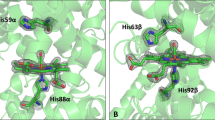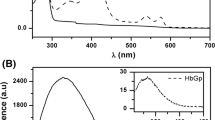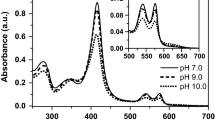Abstract
The tryptic peptides from α- and β-chains of coyote (Canis latrans) hemoglobin have been isolated and their amino acid compositions determined. The compositions are identical to those previously found for dog hemoglobin in all respects except one: the αT-13 peptide of coyote has only threonine at residue 130 of the chain. This indicates only one α-chain in coyote instead of two as in dog, which has one α-chain with threonine and one α-chain with alanine at this position. The α-chain from wolf (Canis lupus) is like that from coyote in having only threonine at residue 130.
Similar content being viewed by others
References
Anson, M. L., and Mirsky, A. E. (1930). Protein coagulation and its reversal. J. Gen. Physiol. 13469.
Baglioni, C. (1965). Abnormal human hemoglobins. X. Study of hemoglobin Lepore Boston. Biochim. Biophys. Acta 9737.
Bekoff, M. (1974). Social play in coyotes, wolves and dogs. Bio-Science 24225.
Carraway, K. L., and Koshland, D. E. (1972). Carbodiimide modification of proteins. In Hirs, C. H. W., and Timasheff, S. N. (eds.), Methods in Enzymology, Vol. XXV, Academic Press, New York, pp. 616–623.
Dintzis, H. M. (1961). Assembly of the peptide chains of hemoglobin. Proc. Natl. Acad. Sci. 47247.
Drabkin, D. L. (1946). Spectrophotometric studies. XIV. The crystallographic and optical properties of the hemoglobin of man in comparison with those of other species. J. Biol. Chem. 164703.
Drabkin, D. L., and Wise, C. D. (1962). Creation of a crystalline interspecies hybrid of hemoglobin at pH close to neutrality. J. Biol. Chem. 237:PC261.
Dresler, S. L., Runkel, D., Stenzel, P., Brimhall, B., and Jones, R. T. (1973). Conference on “Hemoglobins: Comparative Molecular Biology Models for the Study of Disease,” Silver Spring, Maryland, November 14. Proceedings to be published by the New York Academy of Sciences.
Guest, J. R., Carlton, B. C., and Yanofsky, C. (1967). The amino acid sequence of the A protein of the tryptophan synthetase of E. coli. I. Tryptic peptides. J. Biol. Chem. 2425397.
Jones, R. T. (1964) Structural studies of aminoethylated hemoglobins by automatic peptide chromatography. Cold Spring Harbor Symp. Quant. Biol. 29297.
Jones, R. T. (1970). Automatic peptide chromatography. Meth. Biochem. Anal. 18205.
Jones, R. T., Brimhall, B., and Duerst, M. L. (1971). Amino acid sequence of the α- and β-chains of dog hemoglobin. Fed. Proc. 301259.
Konigsberg, W. (1972). Subtractive Edman degradation. In Hirs, C. H. W., and Timasheff, S. N. (eds.), Methods in Enzymology, Vol. XXV, Academic Press, New York, pp. 326–332.
Seal, U. S. (1969) Carnivora systematics: A study of hemoglobins. Comp. Biochem. Physiol. 31799.
Walker, E. P. (1964). Mammals of the World, Johns Hopkins Press, Baltimore, p. 1152.
Author information
Authors and Affiliations
Additional information
This work was supported by Research Grant AM 13173 from the National Institute for Arthritis and Metabolic Diseases.
Rights and permissions
About this article
Cite this article
Runkel, D., Dresler, S.L., Brimhall, B. et al. The tryptic peptides of coyote (Canis latrans) hemoglobin. Biochem Genet 12, 467–473 (1974). https://doi.org/10.1007/BF00486064
Received:
Revised:
Issue Date:
DOI: https://doi.org/10.1007/BF00486064




